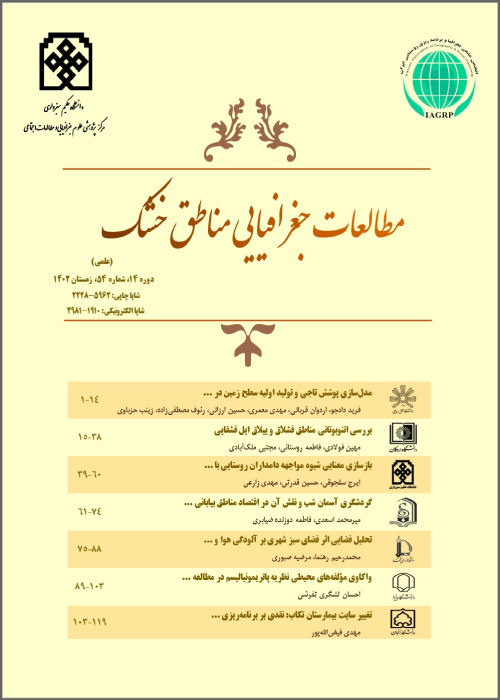The effects of Temperature and Precipitation changes on the occurrence of water resources instability in Zayandeh-Rud Basin
Author(s):
Article Type:
Research/Original Article (دارای رتبه معتبر)
Abstract:
Introduction
Zayandeh-Rud basin in central Iran is a region with water problems. Zayandehrood River that originates from the Zardkuh Bakhtiary Mountain is the most important river of the region for the development of agriculture, and a supply for heavy industry and drinking water sectors and is very important in all of economic activities. In the last decade, the water resources of the basin have decreased, so that part of the length of the River in the middle and downstream of the water flow has dried or temporarily turned off, and the allocation of agricultural water to the agricultural lands of these sectors has decreased significantly. In this study, to analyze the effect of natural factors on instability of water resources in the basin, Investigated Changes in climate indicators such as rainfall, Snow ratio to total rainfall and temperature changes in Chelgerd Station in recent decades. Chelgerd Station is the main source of supply of natural river water and its changes directly affect the water volume of the river. Then, the total water resources of the Basin and changes in the volume of water entering the Zayandeh-rud dam were studied and groundwater changes (number of wells and groundwater level) were compared in two periods of 2006 and 2011. The source of the data is the Iran Water Resources Management (Ministry of Energy) and Meteorological Organization. Natural and human factors in the instability of the basin water can be effective. In this research, is studied the role of natural factor including Temperature and Precipitation changes in the occurrence of instability of water resources in Zayandeh-rud Basin. Based on this, is studied climate change of Chelgerd station (Koohrang) as the main source of natural water supply, In the variables of precipitation, temperature and snow ratio to total precipitation, Then its effects on surface water and Groundwater resources have been investigated in recent decades.
Materials and Methods
The research is based on descriptive-analytical and quantitative method. Research data received from relevant departments, such as Meteorological Organization, Iran Water Resources Management Organization (Ministry of Energy) and Regional Water Company of Isfahan, and has been analyzed according to the research objectives. In each stage of the research has been used from Comments of academic experts and organizational experts Comments. In order to analyze the effect of natural factors on the occurrence of instability of water resources in the Basin, based on available statistics, climate change such as rainfall changes during the period of 50 years (1966-2016), the ratio of snowfall to total rainfall during the 45-year period (1971-2016) And temperature variations during the 30-year period (1986-2016) at Chelgerd station. In addition, due to the importance of the temperature of autumn in the melting of snow reserves, seasonal temperature changes were compared to the long-term average at this station. In the water resources section, firstly, the total water resources of the basin and then changes in the reservoir volume of the Zayandeh-rud dam in the last 45 years have been investigated. In the following, changes in groundwater resources were compared on the basis of two inventory periods in 2006 and 2011. Accordingly, investigated changes in the volume of groundwater aquifers, the number of wells and its rate of discharge in two statistical periods compared with the river flow and the occurrence of water resource instability.
Discussion and Results
Checking the precipitation rate of the Chelgerd station during the 50 years period (1966-2016), shows the trend of the rainfall variable and in the last two decades the precipitation has decreased. In the past two decades, two climatic drought has happened, the first drought in the year 1998-2001, the total precipitation of Koohrang reaches 900-1000 mm per year. During the years of 2001 to 2007, the rainfall is relatively improved and the rainfall reaches over 1500 mm per year. Since 2007, rainfall has fallen in Koohrang station and has reached 900 mm per year; since the beginning of the second drought in the Zayandeh-rud basin, precipitation has been between 900-900 mm per year. Investigation of the rainfall ratio in the period (1971-2016) shows that the ratio of snowfall to rain has decreased over time. While already nearly more than half of the rainfall has been in the form of snow, it has rarely reached 50% since 2001, and less than half of the total rainfall in the Chelgerd area has been snow. Temperature variations over the course of 30 years (1986-2016) show that the temperature has increasing trend and by about 1 degree to the temperature in recent years has increased. In addition, the comparison of the temperature of the fall season in year 2017 compared to the previous year’s shows an increase of 23% compared to the previous year and a 53% increase in temperature compared to the long run. Investigating the variation of Basin water resources by Computing the volume of the input of Zayandeh-rud dam that correlates directly with the volume of precipitation in the Basin, shows a decreasing trend and, in accordance with the dry climatic Courses, the volume of water entering the Zayandeh-rud dam decreased and the volume of water has been usually below 1 billion cubic meters. Investigating the variation in the volume of groundwater in the two census periods (1385 and 1390) indicates that more than 9,000 wells were drilled during this period and an average increase of about 5 meters depth of wells and average groundwater level.
Conclusions
The results of this study indicate that natural factors and climate change have been effective on the occurrence of instability of water resources in the Basin and reduction of River flow, Due to decreasing rainfall and snow-to-rain ratios as well as increasing the air temperature, Basin water resources and the volume of inlet of Zayandeh-rud dam has decreased. With decreasing River flow during these years, water scarcity has been compensated by digging wells. Increasing the utilization of wells and reducing River water flow has reduced groundwater levels in the Basin. Reducing groundwater levels exacerbates the unstable water condition.Keywords:
Language:
Persian
Published:
Arid regions Geographic Studies, Volume:8 Issue: 29, 2017
Pages:
52 to 68
magiran.com/p1982623
دانلود و مطالعه متن این مقاله با یکی از روشهای زیر امکان پذیر است:
اشتراک شخصی
با عضویت و پرداخت آنلاین حق اشتراک یکساله به مبلغ 1,390,000ريال میتوانید 70 عنوان مطلب دانلود کنید!
اشتراک سازمانی
به کتابخانه دانشگاه یا محل کار خود پیشنهاد کنید تا اشتراک سازمانی این پایگاه را برای دسترسی نامحدود همه کاربران به متن مطالب تهیه نمایند!
توجه!
- حق عضویت دریافتی صرف حمایت از نشریات عضو و نگهداری، تکمیل و توسعه مگیران میشود.
- پرداخت حق اشتراک و دانلود مقالات اجازه بازنشر آن در سایر رسانههای چاپی و دیجیتال را به کاربر نمیدهد.
In order to view content subscription is required
Personal subscription
Subscribe magiran.com for 70 € euros via PayPal and download 70 articles during a year.
Organization subscription
Please contact us to subscribe your university or library for unlimited access!



